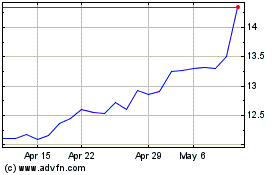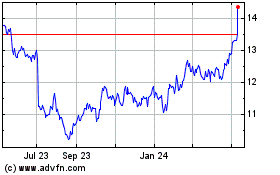BEIJING—China's biggest banks posted their lowest annual profit
growth in a decade, as bad loans mount in an ailing economy that is
pushing lenders toward riskier avenues of expansion.
Three major banks reporting 2015 results on Wednesday said that
they wrote off 142 billion yuan ($21.85 billion) in irrecoverable
debt last year, 1.4 times the volume in 2014, an indication that
their customers—many of them state-owned industrial companies—are
struggling to repay loans.
Bank profits were nearly flat, compared with rates near 40% just
three years ago, with banks building ever-larger capital buffers to
cover bad loans as Chinese companies flounder under a severe
overhang of real estate inventory and excess industrial
capacity.
The prevalence of bad loans means booming business for
asset-restructuring companies—state-owned "bad banks" set up to
soak up and sell off soured debt—prompting conventional banks to
explore ways to keep such deals for themselves.
Net profit among commercial lenders rose 2.4% last year,
compared with 9.6% a year earlier. China's largest bank by assets,
Industrial & Commercial Bank of China Ltd., posted 0.5% profit
growth to 277.1 billion yuan ($42.8 billion).
Profit at Bank of China Ltd., China's fourth-largest lender,
which for the third quarter reported its first profit decline in
six years, rose 0.7% for all of last year.
Industrywide, nonperforming loans rose to 1.67% of total loans
last year from 1.25% in 2014, the China Banking Regulatory
Commission said. Investment bank China International Capital Corp.
estimated the true ratio could be as high as 8.1% this year; other
analysts have projected even higher estimates.
Credit is souring so fast that commercial lenders are having a
hard time expanding capital provisions to keep pace. Two years ago,
China Construction Bank Corp., the second-largest lender, was
setting aside a buffer that was more than twice the size of their
bad loans. Last year, that ratio had fallen to 1.5 times, it said
Wednesday.
Slowing profits have forced many Chinese banks, especially
midsize lenders, to invest aggressively in shadow-banking assets
such as trust and wealth-management products. Such assets, termed
"investment receivables," are opaque cocktails of high-yield risk
that could jeopardize liquidity should banks need to offload them
if markets turn turbulent, analysts say.
"The disclosure for such investment receivables is quite poor,
and it's very difficult to judge the quality of the portfolio,"
said Christine Kuo, senior vice president at Moody's Investors
Service.
Investment receivables at China Citic Bank Corp. rose 70.4% to
1.1 trillion yuan in 2015, the bank said. China's seventh-largest
lender attributed the year-over-year rise to more investments in
directional asset-management plans, which allow banks to repackage
loans as off-balance sheet investments, and wealth-management
products. Similarly, China Merchants Bank Co., the sixth-largest
lender, said its investment receivables rose 75% last year.
As profits at commercial banks flatline, the so-called bad banks
are flourishing. The biggest among them, China Huarong Asset
Management Co., said last week its 2015 profit rose 36% from 2014.
China Cinda Asset Management Co. said Tuesday its profit was up 18%
in the period.
Asset-management companies have been enjoying a buyers' market,
acquiring bad loans at about 30 cents on the dollar, as China's
ailing real estate sector and heavy industries feed a bad-loan
pipeline that is proving lucrative business for those who can
repackage and sell their components. Huarong said the property
sector alone accounted for some 66% of its distressed-debt
acquisitions last year.
At such prices, analysts say, a small number of commercial
lenders are experimenting with complex ways to restructure bad
loans themselves—in one case, by having a bank-related company
broker a deal to subscribe to a debtor's issue of new shares, the
proceeds of which are used to pay off the debtor's bad loans.
A more popular means of disguising bad debt is by parking them
in a category labeled "special mentions," which effectively is "a
vast warehouse for unrecognized nonperforming loans" that isn't
subject to detailed audits, said Ted Osborne, a partner at
PricewaterhouseCoopers in Hong Kong specializing in debt
restructuring.
ICBC reported it had 520.5 billion yuan of special-mention loans
at the end of 2015, an amount nearly three times as large as its
nonperforming loans and 63% larger than in 2014. Bank of
Communications Co. reported 118.1 billion yuan of special-mention
loans in 2015, more than twice the volume of its bad loans.
Banks are facing more problems as Beijing plans to let companies
repay distressed loans via equity transfers to lenders.
Analysts say allowing nonviable companies to take on more
leverage would prolong inefficiencies in the broader economy. "Such
a policy move will likely accelerate bad-loan exposures at banks
and impact their near-term earnings and profitability," said
Bernstein Research analyst Wei Hou.
Such transfers reduce nonperforming loans on paper but could end
up inflicting greater damage on bank balance sheets. These plans
require lenders to set aside four times the value of the equity
investment in capital provisions, far higher than the equivalent
value that needs to be set aside for a regular corporate loan.
Liyan Qi contributed to this article.
Write to Chuin-Wei Yap at chuin-wei.yap@wsj.com
(END) Dow Jones Newswires
March 30, 2016 09:25 ET (13:25 GMT)
Copyright (c) 2016 Dow Jones & Company, Inc.
China Construction Bank (PK) (USOTC:CICHY)
Historical Stock Chart
From Apr 2024 to May 2024

China Construction Bank (PK) (USOTC:CICHY)
Historical Stock Chart
From May 2023 to May 2024
